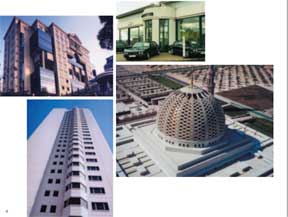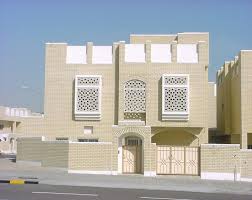|
What is GRC: Glass Fiber Reinforced Concrete ?
Main
Article page |
Beauty articles
|
Health page |
Computers|
Diseases |
Education |
Entertainment |
Family
Business |Fitness|
Fruits and Vegetables
|
Jobs |
General |
Personality|
Technology
|
Tourism |
Sports
House Plans |
House Loans |
Real Estate|
Vaasthu
Shastra|
Construction Tips
Engineering page
| Interior Design |
Property Buying Tips |
Renting Tips |
Journals /
Magazines

Glass Fiber Reinforced Concrete (GFRC),
also known as GRC,
is a type of fiber
reinforced concrete.
Glass fiber concretes are mainly used in exterior building façade panels and as
architectural precast concrete.
It is one of the most versatile building materials available to
architects & Engineers. It consists of fine aggregates, cement, water, chemical
admixtures and special alkali resistant glass fibres. It is used to manufacture
high strength, thin sectioned, prefabricated products
Glass fiber reinforced concrete (GFRC) consists of high strength glass
fiber embedded
in a cementitious matrix.[1] In
this form, both fibers and matrix retain their physical and chemical identities,
while offering a synergism:
a combination of properties that can not be achieved with either of the
components acting alone. In general, fibers are the principal load-carrying
members, while the surrounding matrix keeps them in the desired locations and
orientation, acting as a load
transfer medium between
them, and protects them from environmental damage.
In fact, the fibers provide reinforcement for the matrix and other useful
functions in fiber-reinforced composite materials. Glass fibers can be
incorporated into a matrix either in continuous lengths or in discontinuous
(chopped) lengths.
A widely used application for fiber-reinforced concrete is
structural laminate,
obtained by adhering and consolidating thin layers of fibers and matrix into the
desired thickness. The fiber orientation in each layer as well as the stacking
sequence of various layers can be controlled to generate a wide range of
physical and mechanical properties for the composite laminate. However, GFRC
cast without steel framing is commonly used for purely decorative applications
such as window trims, decorative columns, exterior friezes, or limestone like
wall panels.
The potential for using a glass fiber reinforced concrete system
was recognized by the Soviets in
the 1940s. The early work on glass fiber reinforced concrete went through major
Continued down...
Articles:
-
Construction: What is
GRP or fibreglass ?
-
Interior design : What is
MDF-Medium Density Fiberboard. ?
-
Construction: What is epoxy
based paint?
-
Guidelines and tips: To find a reliable Builder or
Contractor
-
Guidelines & tips
before you start house construction
-
What is top-up housing loan ?
-
Home improvement tips:
Wallpaper for interiors
-
Benefits of rainwater
harvesting in homes
-
Tips & guidelines: Electricity Saving at home
-
Coming Up With Landscaping Ideas
-
How to set out a building on site
-
Interior design: The Rebirth of Wallpaper
-
What
is
Green Building ?
-
What is Domestic biogas plant ?
-
Why home insurance is very important in India?
-
How To Install a Home Wind Turbine
to get energy
-
How to Install Electric Wiring
-
Significance of Home Plumbing
-
Should I buy or rent? A simple calculation
-
Easy Landscaping Tips for Beginners
-
Construction technique:
Rapidwall technology
-
Buying a flat? Don't get carried away by the sample
-
30-storey hotel built in just 15
days
-
Is it worth buying an old
house
-
House plans, home plans, plans, residential plans
-
House Loans, home loans, where to get housing loan
-
How do loans work, the basic concepts of loans
-
Construction Tips, construction guide lines,
-
house rental tips, rental tips, renting properties
-
Real Estate
-
Flooring
-
What is Reverse Mortgage
-
Guidelines to purchase residential properties
-
Lotus-shaped 91 feet prayer hall in kerala
-
What is Interior Design, interior desings, resources
-
Interior Design Colleges
-
Interior Design- Bed Rooms
-
Interior Design- Bath Rooms
-
Kitchen Designs, kitchens
-
Modern Architectural Design Softwares
-
Landscaping Designs landscape architectures
-
-
|
|
Properties:
The design of
GFRC panels proceeds from a knowledge of its basic properties under tensile,
compressive, bending and shear f orces,
coupled with estimates of behavior under secondary loading effects such as
creep, thermal and moisture movement. orces,
coupled with estimates of behavior under secondary loading effects such as
creep, thermal and moisture movement.
There are a
number differences between structural metal and fiber-reinforced composites. For
example, metals in general exhibit yielding and plastic
deformation whereas most
fiber-reinforced composites are elastic in
their tensile stress-strain characteristics. However, the dissimilar nature of
these materials provides mechanisms for high-energy absorption on a microscopic
scale comparable to the yielding process. Depending on the type and severity of
external loads, a composite laminate may exhibit gradual deterioration in
properties but usually would not fail in catastrophic manner. Mechanisms of
damage development and growth in metal and composite structure are also quite
different. Other important characteristics of many fiber-reinforced composites
are their non-corroding behavior,
high damping capacity and low coefficients of thermal expansion.
Glass fiber
reinforced concrete architectural panels have general appearance of pre-cast
concrete panels, but are
different in several significant ways. For example, GFRC panels will, on the
average, weigh substantially less than pre-cast concrete panels due to their
reduced thickness. The low weight of GFRC panels decrease superimposed loads on
the building’s structural components. The building frame becomes
more economical.
Sandwich
panels
A sandwich panel is a composite of
three or more materials bonded together to form a structural panel. It takes
advantage of the shear
strength of
a low density core material and the high compressive and tensile strengths of
the GFRC facing to obtain high strength to weight ratios
The theory of sandwich
panels and functions of the individual components may be described by making an
analogy to an I-beam.
Core in a sandwich panel is comparable to the web of an I-beam,
which supports theflanges and
allows them to act as a unit. The web of the I-beam
and the core of the sandwich panels carry the beam shear stresses. The core in a
sandwich panel differs from the web of an I-beam
in that it maintains a continuous support for the facings,
allowing the facings to be worked up to or above their yield strength without
crimping or buckling. Obviously, the bonds between the core and facings must be
capable of transmitting shear
loads between these two
components thus making the entire structure an integral unit.
The load carrying
capacity of a sandwich panel can be increased dramatically by introducing light
steel framing. The light steel stud framing will be similar to
conventional steel stud framing for walls, except, that the frame is encased in
a concrete product. Here, sides of the steel frame are covered with two or more
layers of GFRC, depending on the type and magnitude of external loads. The
strong and rigid GFRC provides full lateral support on both sides of the studs,
preventing studs from twisting and buckling laterally. The resulting panel is
light weight in comparison with traditionally reinforced concrete, yet is strong
and durable and can be easily handled
ADVANTAGES
Light weight: Although
GRC has a similar density to concrete the products made from it are many times
lighter due to the thin 10-15mm skin thickness used. A cladding panel
manufactured from 100mm thick precast concrete would weigh 240kgs per m2
compared to a similar GRC panel of 40-50kgs/m2.
In fact many GRC products can
be lifted and carried by hand an important consideration with strict manual
handling regulations now being introduced in many countries.
Appearance: GRC has a
wide flexibility in design and manufacture, which enables it to reproduce most
architectural styles and features. It can replicate virtually any surface detail
and reproduce the appearance of materials such as stone, slate, terracotta and
marble. Carved stonework involves specialised skills and is slow to produce
making the end product expensive.
GRC can match stonework in
appearance and as it can be produced in thin sections it is easier to handle and
fix.
Cost effective: GRC
Products have been shown to provide economic solutions to many applications.
Although the manufacturing
costs may be higher than say concrete when the reduced handling, transport and
fixing costs are considered there can be an overall saving.
Corrosion and rot proof:
GRC products do not contain mild steel reinforcement and the problems associated
with corrosion of reinforcement do not apply.
GRC is unaffected by external
exposure and will not rot. It is completely unaffected by exposure to UV light.
Incombustible: Most GRC
formulations comply with non-combustible criteria for UK and EU standards.
Polymer GRC is not classed as
non-combustible but conforms to the requirements of Class O defined by the
British Building Regulations.
PRODUCTION TECHNIQUES
Hand Spray is the most
versatile and popular production technique and the one normally chosen by new
start-ups. A special spray gun is used to simultaneously deposit chopped glass
fibre and cementitious slurry onto a mould.
This is then compacted by hand
using a spring roller. A second layer is then sprayed and again compacted. Using
the spray technique allows high glass percentages to be used and this gives the
highest mechanical properties. In turn this allows for reduced skin thickness
and lighter products.
Auto Spray: The hand
spray process can be automated or semi-automated. More common are semi-automatic
processes where the spray gun is mounted on a reciprocating traverse with the
moulds passing underneath on a conveyor.
Compaction can be by hand or
via a dewatering system. These systems are ideal for the production of flat
products and they can also be very versatile when used with folding moulds.
Cast Premix: As the
name suggests the glass fibre is mixed into the cementitious slurry and the
resulting material is poured or pumped into moulds and compacted using vibration
or by using special additives in the mix.
The premix process can be
easily automated and is often chosen for standard product manufacture. The
moulds used are more complex than those for the spray process. The mechanical
properties are lower but they are consistent allowing optimum design.
Sprayed premix: This is a
combination method where the premixed material is sprayed onto the mould.
It combines the advantages of
both methods and is becoming the method of choice for many small architectural
items.
( Reference
http://fibretech.org/, Wikkipedia )
| 



